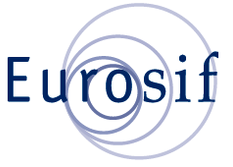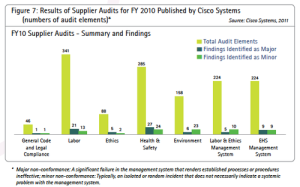Tags
conflict minerals, CSRwire, dodd-frank act, eicc, ESG, eurosif, procurement, supply chain audit, supply chain management, Supply chain management, Sustainability, sustainability, transparency, un guiding principles on business and human rights
An interview with François Passant, Executive Director of Eurosif, the European Sustainable Investment Forum
What are the critical points investors should know about this report?
François Passant: The Eurosif Procurement Report reveals – one of the first such reports – how investors can systematically minimize supply chain  risks against the backdrop of an exponential growth in outsourcing to low-cost regions such as Asia, and recent environmental disasters such as
risks against the backdrop of an exponential growth in outsourcing to low-cost regions such as Asia, and recent environmental disasters such as
Fukushima.
Researched by privately held swiss Bank Sarasin, the report illustrates the factors that are considered in a robust sustainable supply chain audit and offers best practices used by multinational companies in the textiles and electronics sectors in monitoring different tiers of suppliers. We focused on these two industries primarily because they have particularly long and complex supply chains, though there are variations even in these sectors.
It also helps practitioners frame the business case for responsible supply chain management.
What are the main contributing policies and standards highlighted by the report?
Responsible supply chain management requires recognition of the relationship between environmental, social, legal and reputational risks and financial performance.
There is a range of legal and quasi-legal measures, international and self-regulatory codes of conduct and standards aimed at improving the sustainability of supply chains. Examples include:
1. The Electronics Industry Citizen Coalition [EICC] Code of Conduct
Many more large textiles brands now require compliance with minimum labor standards and therefore conduct supplier audits. According to the Eurosif report, this has led to an improvement in issues such as child labor, forced labor, occupational health and safety.
Most leading electronics companies have a Code of Conduct that is based upon the Electronics Industry Citizen Coalition (EICC) code, an industry initiative which is supporting positive changes on social and environmental issues.
2. The Dodd-Frank Act
Legal restrictions such as the Dodd-Frank Act in the U.S. will demand that companies reveal the source of their minerals’ procurement to reduce the use of raw materials mined under primitive and hazardous conditions.
3. Guiding Principles on Business and Human Rights
The UN Human Rights Council endorsed the Guiding Principles on Business and Human Rights in June 2011, which define the responsibilities of companies to protect human rights in their operations and supply chains. Although it is not legally binding, the principles offer a clear direction for the future.
4. EU Directive 2002/95/EC
 Legal and quasi-legal pressures also affect environmental risks. Some substances are regulated and phased out by the EU Directive 2002/95/EC on the Restriction of the use of certain Hazardous Substances in Electrical and Electronic Equipment (RoHS). Similarly certain substances are under observation for future regulation in the frame of the EU regulation on Registration, Evaluation, Authorisation and Restriction of Chemicals (REACH).
Legal and quasi-legal pressures also affect environmental risks. Some substances are regulated and phased out by the EU Directive 2002/95/EC on the Restriction of the use of certain Hazardous Substances in Electrical and Electronic Equipment (RoHS). Similarly certain substances are under observation for future regulation in the frame of the EU regulation on Registration, Evaluation, Authorisation and Restriction of Chemicals (REACH).
5. European Commission’s Roadmap to a Resource Efficient Europe
In 2011, the European Commission published the Roadmap to a Resource Efficient Europe, as one of the flagships of the Europe 2020 Strategy. A key element of the roadmap is the promotion of sustainable production by setting appropriate price signals and defining a common methodological approach to measure environmental performance (environmental footprints) of products and services.
Consumer pressure is also a driver for positive change. The market for green, ethical and organic — organic cotton sales tripled in the last six years (Textilexchange, 2011) – products has grown rapidly in recent years and is projected to continue at this fast pace.
What are some best practices on capacity building and supply chain monitoring standards revealed by the report?
One of the biggest challenges is getting improvements along the supply chain from direct suppliers to raw material producers.
Leading companies have a multi-stage process, starting with risk assessment to identify suppliers with a high exposure to labor and environmental issues, followed by self-assessments, and finally regular on-site audits at key supplier factories carried out by internal staff or external auditors. In the case of non-compliance findings, corrective action plans are defined. Some electronics companies like Hewlett-Packard or Cisco Systems publish the results of their audits.
However, in general, transparency in the apparel and textile industry is more advanced than the electronics sector.
There is an upward trend in companies reporting on audit results including non-compliance cases; some even disclose their suppliers. Leading sporting goods and retail companies have supplier performance measurement mechanisms that have been fully integrated into their supplier assessment and their order placements. Puma and Adidas Group are cited in the report as companies which are relatively transparent about their sustainable supply chain auditing.
Collaborative and capacity building efforts are included in the sustainable supply chain audit. Leading apparel brands have been working together to improve labor standards in their supply chains. Examples include the Better Work partnership between the International Labor Organization (ILO) and the IFC and cooperation with the Fair Labor Association.
Environmental projects are more focused on materials. Examples include the Leather Working Group and Better Cotton Initiatives.
Other highlights that link sustainability and risk assessment?
Other sustainability-related supply chain disruptions mentioned in the report include:
- Energy scarcity
- Incidents related to health and safety
- Environment
- Product safety
- Business ethics
A loss of productivity led by supply chain disruptions affects revenue and increases costs.
In a recent survey, 74 percent of surveyed companies agreed that outsourcing and just-in-time strategies were making their organizations more vulnerable to supply chain disruption.
How does the report expand the dialogue on ethical sourcing and supply chain management?
The report discusses supply chain management and sourcing materials from an investor’s perspective regarding environmental and labor issues in particular and their compliance with international laws, regulations and standards as mentioned above.
Investors are advised to adopt a robust supply chain audit, which includes:
- An assessment of the extent of outsourcing
- Assessment of the locations of suppliers
- Corporate policies and standards (including industry and legal)
- Effective monitoring procedures
- Capacity building along the supply chain
- Active collaboration within the industry and with stakeholders
- Clear product labeling
The sustainable supply chain audit is described in more detail in Eurosif’s Procurement Report, which can be downloaded from Eurosif.com [PDF].
Originally written for and published on CSRwire’s Commentary sectionTalkback on April 10, 2012.
